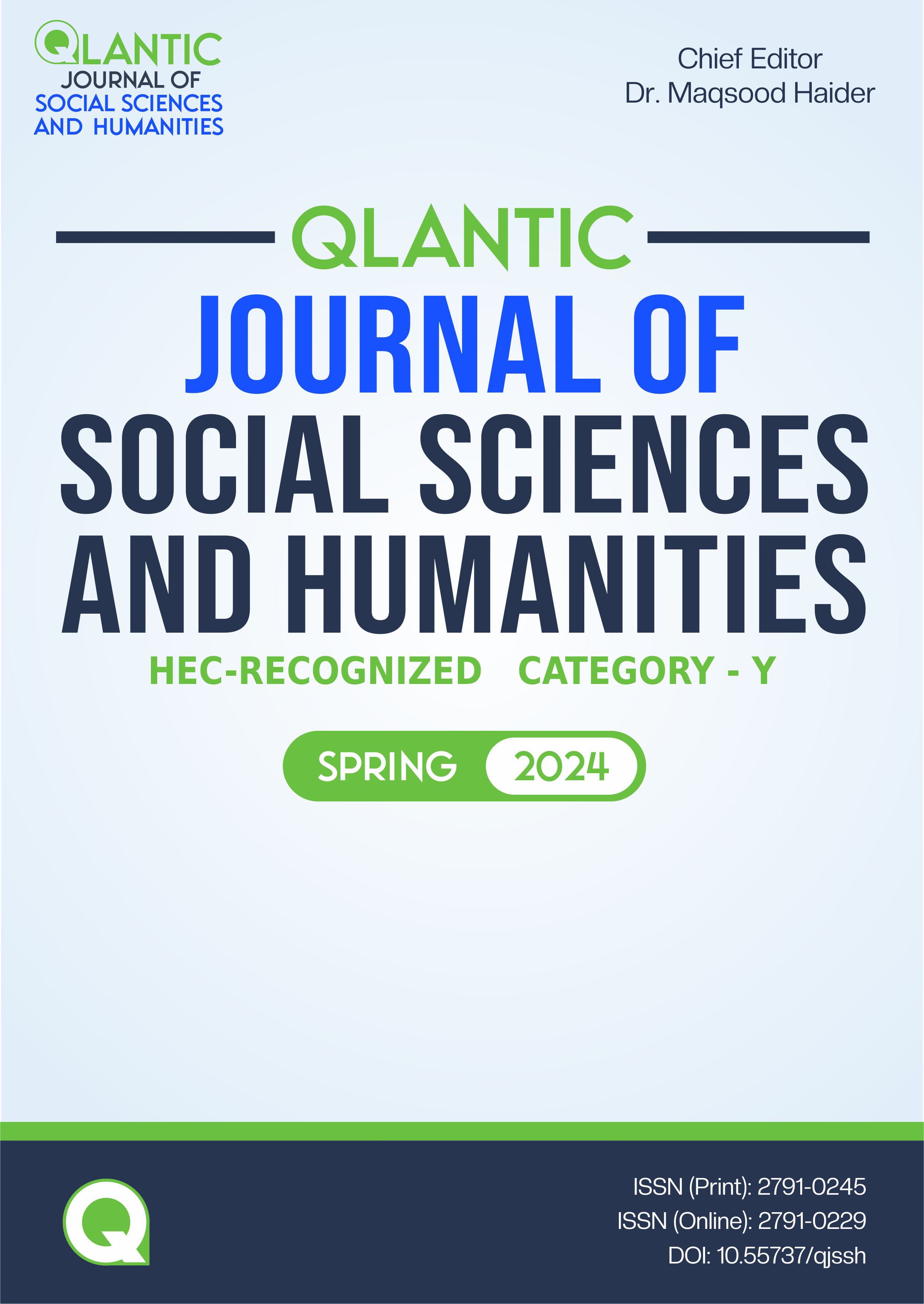Role of Non-verbal Communication Skills of Teachers and its Impact on Achieving Classroom Learning Objectives at Secondary Level
DOI:
https://doi.org/10.55737/qjssh.179316368Keywords:
Communication, Verbal Communication, Non-verbal Communication, Classroom Learning ObjectivesAbstract
This descriptive study intends to investigate the influence of a teacher’s nonverbal communication on classroom learning objectives using a descriptive technique. This also determined the association between the unspoken behaviours of teachers working in various educational systems. The main objective of the research is to understand how non-verbal communication skills, including facial expressions, eye contact, pitch of voice, and physical appearance, collectively contribute to achieving classroom learning objectives. The quantitative survey method was used to present the study. This research was descriptive in nature. A 5-point Likert scale questionnaire was developed for data collection. This questionnaire was administered to a sample of 400 respondents who were randomly selected from 40 public and private secondary schools in Multan. Using SPSS software, the acquired data was tabulated and evaluated. The collected data was tabulated, analysed, and interpreted in the form of mean, frequency, percentage, and standard deviation. Both descriptive and inferential statistics were used to arrive at the conclusions. Frequencies and percentages were computed to illustrate the demographic items and questions, and one-way ANOVA and the independent sample t-test were utilized to illustrate the variations in teacher perspectives depending on various factors related to demographics.
References
Abbo, U. H. (2021). The Impact of Cultural Diversity on Business Marketing Communication in Yola North. International Journal of Business & Law Research, 9(3), 105-111. https://seahipaj.org/journals-ci/sept-2021/IJBLR/full/IJBLR-S-10-2021.pdf
Abubakr, S., Bingol, M., & Kara, S. (2022). Body Language in Education and Effective Recommendations to Pre-Service Teachers in Classroom Management. International Journal of Social Sciences & Educational Studies, 9(1). https://doi.org/10.23918/ijsses.v9i1p298
Ballester, E. P. (2015). Verbal and nonverbal teacher immediacy and foreign language anxiety in an Efl University course. Porta Linguarum Revista Interuniversitaria de Didáctica de las Lenguas Extranjeras, (23), 9-24. https://doi.org/10.30827/digibug.53759
Baroona, P. (2019, November). The Impact of Non-Verbal Communication on the Learning Process. https://ejurnalunsam.id/index.php/ELLITE/article/download/1738/1331
Bell, S. (October 23, 2003). Direct Teaching of Non-Verbal Social Communication Skills. ASD workshop-OCCSB.
Bhatti, M. T., & Teevno, A. R. (2021). Nonverbal Communication (NVC) and teacher presence in collaborative online learning. Journal of Contemporary Issues in Business and Government, 27(06), 105–111. https://doi.org/10.47750/cibg.2021.27.06.027
Butt, M. N. (2011). Impact of Non-Verbal Communication on Student Learning Outcomes. (Doctoral dissertation, Sarhad University of Science and Information Technology, Peshawar-Pakistan).
Darn, S. (2005). Aspects of nonverbal communication. The Internet TESL Journal, XI(2).
Elumalai, P., Yadav, Y., Williams, N., Saucan, E., Jost, J., & Samal, A. (2022). Graph Ricci curvatures reveal atypical functional connectivity in autism spectrum disorder. Scientific Reports, 12(1), 8295. https://doi.org/10.1038/s41598-022-12171-y
Fahim, U. K. (2020). Welcome to Pakistan research repository: Impact of nonverbal behavior of teachers on students’educational accomplishment. https://prr.hec.gov.pk/jspui/handle/123456789/14800
Farid, N., Khan, G. A., Ullah, E., Parveen, R., Khalid, T., Ullah, A., & Noor, I. (2023). Effectiveness of verbal and non-verbal communication for teaching and learning at University level. Journal of Education and Social Studies, 4(3), 635-644. https://doi.org/10.52223/jess.2023.4323
Haataja, E., Salonen, V., Laine, A., Toivanen, M., & Hannula, M. S. (2020). The Relation Between Teacher-Student Eye Contact and Teachers’ Interpersonal Behavior During Group Work: a Multiple-Person Gaze-Tracking Case Study in Secondary Mathematics Education. Educational Psychology Review, 33(1), 51–67. https://doi.org/10.1007/s10648-020-09538-w
Hassan, M. M. T. (2007). Nonverbal Communication: The Language of Motivation for Pakistani Students. Language in India, 7(8), 1-21.
Khan, P. (2023). Impact of Teachers’ Adverse Non-Verbal Communication on University Students’ Learning Outcomes (Within Classroom). Journal of Positive School Psychology, 7(6), 1289-1301. https://journalppw.com/index.php/jpsp/article/view/17592/11091
Kožić, D., Globočnik Žunac, A., & Bakić-Tomić, L. (2013). Use of non-verbal communication channels in the classroom / Neverbalni komunikacijski kanali u nastavi. Croatian Journal of Education - Hrvatski časopis za odgoj i obrazovanje, 15. https://doi.org/10.15516/cje.v15i0.629
Küçük, T. (2023). Factors Leading to Writing Anxiety in EFL Classes. International Journal of Social Sciences & Educational Studies, 10(1), 1. https://doi.org/10.23918/ijsses.v10i1p1
Lierheimer, K., & Stichter, J. (2012). Teaching facial expressions of emotion. Beyond Behavior, 21(1), 20-28.
Monika Srivastava, (NA). Effective communication skills: need & importance for teacher. Anand College of Education, Unit of Sharda Group of Institutions (SGI), AgraMember, Play India Play (Trust). https://www.scribd.com/doc/62753783/EFFECTIVE-COMMUNICATION-SKILLS-NEED-IMPORTANCE-FOR-TEACHERS
O'Rourke, D. J., Lobchuk, M. M., Thompson, G. N., & Lengyel, C. (2020). Video feedback: A novel application to enhance person‐centred dementia communication. International Journal of Nursing Practice, 26(4). https://doi.org/10.1111/ijn.12820
Pan, Q. (December 2014). Teacher and Student Communication in Foreign Language Classroom. 2014 ACADEMY PUBLISHER FINLAND, 2629.
Sng, B. (2012). The impact of Teachers’ communication Skills on teaching: Reflection of pre-service teachers on their communication strength and weakness. harmonizing language teaching.
Witt, P. L., & Wheeless, L. R. (2001). An experimental study of teachers’ verbal and nonverbal immediacy and students’ affective and cognitive learning. Communication Education, 50(4), 327-342. https://doi.org/10.1080/03634520109379259
Yang, X. (2017). The Use of Body Language in English Teaching. Theory and Practice in Language Studies, 7(12), 1333–1336. https://doi.org/10.17507/tpls.0712.23
Published
Issue
Section
License
Copyright (c) 2024 Qlantic Journal of Social Sciences and Humanities

This work is licensed under a Creative Commons Attribution-NonCommercial 4.0 International License.





